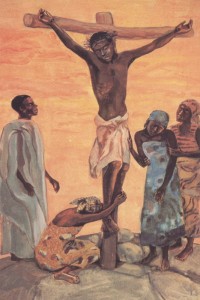
A number of my colleagues recommended I read What is the “Good News” of Jesus Christ?*, delivered by David Suryk at the 2016 Midwest Faculty Conference (Cedar Campus, 6/19/2016). When I had opportunity to connect with David at this summer’s Midwest Faculty Conference, I asked him not only for a copy of What is the “Good News” of Jesus Christ?, but also the permission to share the sermon with the Emerging Scholars Network via a series on the blog (Part 1, Part 2, Part 3, Part 4). “Thank-you!” to David for the series and Hannah for editing. What a joy in this post not only to continue exploring how all four Gospels have the same crucial structure telling the Jesus story, but also read the good news shared at the end of the post. To God be the glory! ~ Tom Grosh IV, Associate Director, Emerging Scholars Network
WHO IS JESUS? Con’t
In broad strokes, all four Gospels state at the beginning that Jesus is Israel’s King. Jesus’s baptism with the Holy Spirit was his anointing as Israel’s King, just as the Spirit in the Old Testament came upon Saul and later on David when they were anointed as Israel’s kings (see 1 Samuel 10:10b; 16:13b-14; 2 Samuel 7:15-16; cf. Psalm 51:11 where David prayed after his sin with Bathsheba. “Do not cast me away from your presence and do not take your holy spirit from me” = do not tear the kingdom from me as you did to Saul).
All four Gospels next show Jesus first summoning Israel back to God by calling them to repent and to believe in himself and his way of being Israel. Remember our Matthew reading in which Jesus sent his disciples to announce that the kingdom of Heaven had come near. He told them not to go to the Gentiles or to the Samaritans but go only to the lost sheep of the house of Israel (10:5-7).
All four Gospels tell how Jesus entered Jerusalem for the last time hailed by the crowds as Israel’s King—think Palm Sunday. All four Gospels only report the conversation between Jesus and Pilate as being about whether Jesus was Israel’s King. All four Gospels next say that Jesus was crucified with the placard that crosread “King of the Jews”—think Good Friday.

[ And then we also have Psalm 22. When Jesus was on the cross and he cried out, “My God, my God, why have you forsaken me?” (Matthew 27:46), he both quoted and alluded to Psalm 22. Throughout Church history Christians have looked to that Psalm as depicting crucifixion (22:1-18). But next comes a section in the Psalm that speaks of his deliverance (22:19-21) and then there is praise throughout the congregation of Israel (22:22-26). But then amazingly the rest of the Psalm (22:27-31) is about all the families of the nations turning to the Lord to whom all rule and dominion belongs. From the cross Jesus seemed to have alluded to what he had come to do first for Israel and then also for the entire world. ]
Jesus had to die on a cross because he was Israel’s representative King. Jesus was the faithful Israelite whom God sent to be Israel’s true King. And as Israel’s King, he took upon himself the curse of the Law so that all—Jews and Gentiles alike—could have salvation in King Jesus and receive the same Spirit.
In the hymn, What Wondrous Love is This there is a crucial error in verse 2. That verse says, “When I was sinking down beneath God’s righteous frown, Christ laid aside his crown for my soul….” That simply misses the point. Christ died with his crown firmly on his head as Israel’s King so that the benefits of his kingship could flow to all who believe, to the Jew first and to the Gentile.
Moving on, all four Gospels next say that the resurrected Lord Jesus sent his Jewish disciples out into the world to make disciples of all the nations, of all peoples and ethnicities as our Matthew 28 reading says—think Easter Sunday.
Luke even demonstrated this pattern in the book of Acts. In Acts 1:8 we read, “But you will receive power when the Holy Spirit has come upon you; and you will be my witnesses in Jerusalem, in all Judea and Samaria, and to the ends of the earth.’” It’s no accident that the Book of Acts is organized this way.
We need to add here that in all four Gospels we see Gentiles coming into the Kingdom of God by responding to King Jesus. Examples include the Magi coming to worship the new born King and the Canaanite woman from the region of Tyre and Sidon coming to Jesus in faith for him to cast out the demon who tormented her daughter. In John chapter 10:16-18 Jesus even spoke about having another flock of sheep besides the sheep of the house of Israel that he would shepherd into one flock by his death and resurrection. In Ephesians chapter 2 Paul unpacked what Jesus meant about uniting the two flocks in one Shepherd (see also, John 11:51-53).
[ One of my favorite parts in the Fourth Gospel is chapter 12 where some God-fearing Greeks wanted to see Jesus. Throughout the Gospel Jesus’s hour had not yet come. But when some Greeks come to Philip (the disciple with a Greek name) saying they want to see Jesus, Philip told Andrew and together Philip and Andrew told Jesus. Then, and I often get chills when I read this, “Jesus answered them, ‘The hour has come for the Son of Man to be glorified. Very truly, I tell you, unless a grain of wheat falls into the earth and dies, it remains just a single grain; but if it dies, it bears much fruit.” (John 12:23-24) The hour had finally come for Jesus to die and to rise from the dead so that persons from among all the nations could come into the Kingdom of God by faith in the Lord Jesus Christ and not by adhering to the Jewish Law. ]
For the past year and a half, I had the privilege of walking through the Jesus Story with a visiting professor from a closed country.** He had no idea who Jesus was before coming to the States though he had heard of Christianity. As we walked through Luke’s Gospel we talked about everything that I have just presented to you this morning and so much more about God, Jesus and the Gospel. For him, believing was not at all easy because it meant being a baptized follower of Jesus in what he called “the Empire” of his home country. Throughout the weeks and months we met, which was twice each week for 90 minutes, I would ask him what he thought about the Lord Jesus. He would smile and keep saying, “I’m still doing research.” My NT reading for October 5, 2015 was Philippians 1 and it occurred to me that the backdrop to all of the New Testament was following Jesus as Lord despite persecution. And so when we met later that day we read through selected passages in Philippians and I asked if he could trust this Jesus with his life and his future. He looked out the window and then said, “I have done enough research. I believe. I want to be baptized.” I turned him over to my pastor who prepared him for baptism and that happened on January 10, 2016 which, in the liturgical Church year, is “The baptism of our Lord.” . . . .
For the Conclusion of the series, click here.
—
Texts for your prayerful consideration as you engage this series: Matthew 10:1-15; Matthew 28:16-20; Romans 15:7-13; and Philippians 2:5-11.
*Material in [ ] were omitted during preaching. Note: The picture was taken during a time of reflection at the 2017 Midwest Faculty Ministry Conference / Cedar Campus.
**Details more generalized than original presentation.
David Suryk has served InterVarsity with Graduate and Faculty Ministries (GFM) since 1991 at the University of Illinois at Urbana where he also did his graduate work in philosophy. He says he’s a recovering analytic philosopher. He seeks to help GFM be faithful to our calling to the University among graduate students and faculty and especially in the area of the Gospel, Jesus and evangelism. He enjoys woodworking and home remodeling as well as using graduate students to help with these projects.

I do find it ironic to see an African “Jesus” portrayed when what the apostle Paul said was crucial is that Jesus had to be born a Jew. There are our Western (and white) cultural distortions of the biblical Jesus, but also non-Jewish cultural distortions (African, in this case). I get the point that this is art and by the Cameroon African Christian community to see themselves in Jesus. But I think Paul would affirm that Jesus had to be born under the Jewish Law that he might fulfill that law as well as to abolish the Law in his body uniting believers of every and all ethnicity. See Galatians 4:4-5—”But when the fullness of time had come, God sent his Son, born of a woman, born under the law, in order to redeem those who were under the law, so that we might receive adoption as children.” I think we need to work keep Jesus in his own cultural and historical context so we don’t miss the way the apostle Paul said we should understand the Jesus Story.
David, Thank-you for sharing your concerns. Please forgive me for not responding earlier. As I am re-highlighting your excellent series through ESN’s social media, I thought I would be remiss not to offer some alternative renderings more closely tied to our understanding / perspective regarding a Jew in 1st-century Judaea.
According to Joan E. Taylor (Professor of Christian Origins & Second Temple Judaism, King’s College London) in What did Jesus really look like, as a Jew in 1st-century Judaea? (Irish Times, 2/9/2018), “Thus in the end we see him [Jesus] as a man of Middle Eastern appearance, with scruffy, shortish hair and beard, wearing very basic clothing: a knee-length, thin, one-piece tunic and an undyed mantle.” https://www.irishtimes.com/culture/books/what-did-jesus-really-look-like-as-a-jew-in-1st-century-judaea-1.3385334.
I see that Joan E. Taylor received a lot of attention in Spring 2018 due to her new publication What Did Jesus Look Like? (T&T Clark, 2018, https://www.bloomsbury.com/us/what-did-jesus-look-like-9780567671509/). I appreciated her pictures and analysis in an earlier article: What did Jesus really look like? (BBC News, 12/24/2015, https://www.bbc.com/news/magazine-35120965).
On Jesus Creed, Scot McKnight commented on Taylor’s book and offered a sketch in What Did Jesus Look Like? (2/15/2018), http://www.patheos.com/blogs/jesuscreed/2018/02/15/jesus-look-like/.
It seems that the work of Richard Neave, a medical artist retired from The University of Manchester in England and the co-author of Making Faces: Using Forensic And Archaeological Evidence, is still the most popular in “educated” circles. Note: “The Real Face Of Jesus: Advances in forensic science reveal the most famous face in history” from Popular Mechanics (Mike Fillon, 1/23/2015), https://www.popularmechanics.com/science/health/a234/1282186/. Along similar lines, but full person there is an image which I think may be helpful at What Did Jesus Really Look Like? New Study Redraws Holy Image by Owen Jarus (Live Science, 2/27/2018), https://www.livescience.com/61875-what-did-jesus-look-like.html.
Looking forward to your insights. Great to have you part the team of contributors to the Emerging Scholars Network blog. To God be the glory!